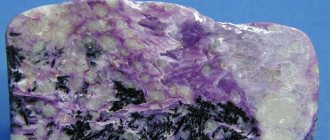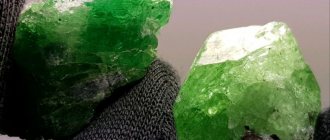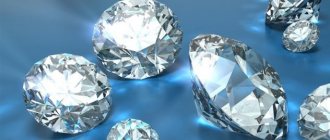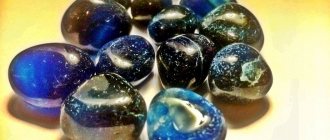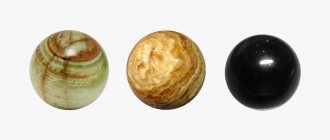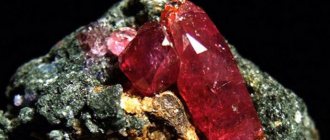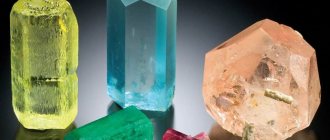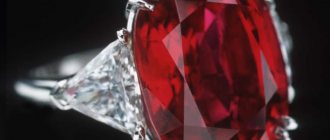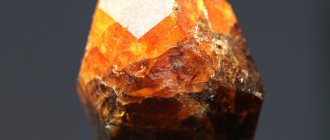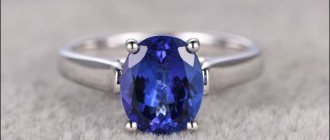Cubic zirconia is an exceptional stone that differs sharply from its natural counterparts. Cubic zirconia is created in artificial laboratory conditions, and is not mined in the usual way in mountainous areas. Abroad, the stone is better known as dzhevalite, zirconite, daimonskvay. It’s interesting that everything has a natural analogue, Pribaikalsky tazheranite.
History of the creation of the stone
Cubic zirconia is an example of the triumph of technology in copying processes occurring in nature. The crystals are obtained from zirconium dioxide, after processing they are very similar to diamonds; in the USSR, artificial diamonds were called cubic zirconia.
Creation of cubic zirconia
In the 1960s, experiments were carried out at the Lebedev Physical Institute of the Academy of Sciences (FIAN) with the composition necessary for laser equipment. The by-products of these studies turned out to be shiny pebbles, which were considered defective. The institute’s employees took them as souvenirs, and some enterprising citizens set up sales of processed stones to Western countries. There, of course, they were happy to see such cheap “diamonds,” but they soon realized that they were fake.
And in the USSR, these stones were called cubic zirconia (in honor of the institute where they appeared), and scientists, on instructions from the government, created their colored analogues. Beautiful crystals filled the shelves of jewelry stores, their prices were affordable for most Soviet people. There was even a plan for the release of cubic zirconia.
These stones began to be produced in other countries. In 1990, 50 million carats entered the jewelry market . The pace of their production is still growing.
Confusion with names
These stones are called cubic zirconia only in the former Soviet republics and Eastern Europe. In other countries they have different names:
- Shelby;
- zirconite;
- jevalit;
- cubic zirconia;
- daimonsquay.
Sometimes cubic zirconia is called zirconium or zircon, which is absolutely wrong, because:
- cubic zirconia - a synthetic imitation of diamond;
- zircon is a natural mineral;
- zirconium is a metal (only its cubic dioxide has a crystal form).
Such confusion with names arose due to the fact that in many countries they do not want to recognize the authorship of Soviet physicists.
Name confusion
Only residents of our region know what cubic zirconia is. Foreigners know this crystal under a completely different name:
- Dzhevalit;
- Daimonsquay;
- Zirconite.
It is also called zircon, although these are completely different stones. Zircon, unlike cubic zirconia, is a precious stone. A synthetic mineral, as we know, cannot rightfully be considered precious. There are also more ridiculous incidents - cubic zirconia is often confused with zirconium, a chemical element.
Why didn’t our name catch on abroad? The reason is the following - some countries simply did not want to recognize the authorship of the invention. And, of course, don’t forget about the unpleasant story with fake diamonds.
Cubic zirconias are also confused with Swarovski crystals, calling them "Swarovski cubic zirconias". But these are completely different things. We talked more about crystals from Swarovski in this article.
Physicochemical characteristics
Cubic zirconia is an artificial mineral that is grown in laboratory conditions. Its basic chemical formula - zirconium dioxide - can vary depending on the components introduced during the synthesis of the crystals. This is done in order to give the stone various specified properties.
In appearance and structural structure, cubic zirconia resembles a diamond.
- Chemical formula - Zr0.8 Ca0.2 O1.92 .
- Color - green, golden brown, orange, yellow, pink, purple.
- The shine is diamond.
- Transparency - transparent.
- Hardness - 7,5–8,5.
- Cleavage is absent.
- The fracture is uneven.
- Density - 6.5–10 g/cm3 .
The growth rate of cubic zirconia crystals in laboratories is 1 cm per hour.
Compatibility with other stones
It is known that the magical properties of stones are revealed more strongly when combined with other gems. We are dealing with an artificial analogue of diamond. The duplicate is able to “adapt” to its “neighbor” and enhance its properties. The crystal gets along with any precious or semi-precious stone and reveals its mystical properties.
Earrings with garnet and cubic zirconia.
cubic zirconia colors
Classic cubic zirconia is colorless, but technologists can create specimens of different colors, and even three-color stones. They have the power to give the mineral more than forty shades. To do this, it contains the following substances:
- copper - turns yellow;
- titanium - brown;
- erbium - pink;
- aluminum or cobalt - blue;
- neodite - red;
- chrome - green.
Even the color of lavender is obtained, which is not found in natural minerals. But it has not yet been possible to obtain an emerald color.
Scientists have made it possible for this stone to exhibit a color changing effect, which makes it possible to imitate alexandrite.
To obtain white and black stones, transparent brown, green or yellow specimens are heat treated.
In jewelry, cubic zirconia duplicates precious stones:
- red - ruby or garnet;
- green - chrome diopside;
- blue - sapphire;
- blue - topaz;
- purple - amethyst;
- yellow - citrine;
- golden - chrysolite;
- black - carbonado.
Cubic zirconia itself can be considered as an analogue of a natural mineral: tazheranite, which was found in the Baikal region, has characteristics comparable to the properties of this artificial stone. It received its name from the Tazheran Gorge, where it was found. Tazheranite crystals are small and are not used in jewelry.
Differences between cubic zirconia stone and diamond
In most cases, this mineral imitates a diamond. However, they have different chemical structures. Cubic zirconia is zirconium dioxide, while diamond is an allotropic form of carbon.
When purchasing a gemstone, it is better to seek the help of a professional. In order to distinguish cubic zirconia from a diamond, you will need special equipment.
A diamond has 57 facets. And its analogue has significantly fewer of them. Specialists can produce the required number of edges. However, in order for cubic zirconia to acquire the internal dual glow of a diamond, magnification and special lighting are necessary.
The weight of cubic zirconia is greater than that of a diamond. In addition, it has a higher degree of transparency. Through the artificial stone you can see the surrounding objects.
To independently determine the authenticity of a diamond, you need to apply fat to the jewelry. A real gem will hold it, but an artificially synthesized one will not.
Medicinal properties
Cubic zirconia has a dual nature: it has a natural base and structure, like a diamond, but it is created, by the standards of natural stones, almost instantly. Do cubic zirconia have healing and magical properties? This question gives rise to controversy among lithotherapists.
Some believe that it has the energy of the base substance that it received during creation.
Others believe that artificial stone is not capable of exerting any magical or healing effects.
According to the first, contemplation of cubic zirconia gives a positive attitude, increases the body’s defenses, and helps to recover from stress, illness, or surgery.
Traditional medicine has appreciated such properties of cubic zirconium dioxide as thermal stability, high hardness, and low cost. It is used for the manufacture of microscalpels, and in dentistry for ceramic spraying.
Field
As already noted, stone is not a natural resource. It is grown artificially in laboratories. Its properties are as close as possible to diamonds, but in fact it is a modification of zirconium dioxide. Therefore, the fact that it is often called zirconium is acceptable. However, the latter is still mined in nature, and cubic zirconia is the brainchild of scientists and physicists.
Cubic zirconia can perfectly pass for a diamond, zirconium or other precious stone, since over time they learned to color a pure sample. It is interesting that other countries are also engaged in the synthesis of stone, but the Russian one, developed within the walls of the Lebedev Physical Institute, still produces stones of the best quality.
Magic properties
Cubic zirconia is a synthetic stone, so it has no magical properties. But many esotericists do not agree with this. They believe that what properties a stone will have depends on its owner. It is believed that this stone is a kind of vessel that a person fills with his emotions, thoughts, and energy. The mineral remembers all this and returns it to its owner. In order for positive energy to accumulate in it, it is better not to wear the stone during difficult periods of life and to wear it during periods of successful achievements.
Communicate with cubic zirconia when you are in a good mood, say what help you need, and then over time you can turn it into your own amulet.
Cubic zirconia should not be allowed to be handled by other people, even for a short time. If the stone was received as a gift and was previously owned by another person, you need to cleanse it of other people’s energy: hold it in spring water.
If you follow these recommendations, the magic of the stone will be in tune with you.
It is believed that this crystal especially patronizes creative people and scientists. A person who works with a large amount of information will benefit from a pendant or ring with this stone.
The magical properties of cubic zirconia help to increase the overall tone of the body, activate vitality and do a very large amount of work in a short period of time. Therefore, it is suitable for journalists and travelers who want to visit more countries.
The value of cubic zirconia for a person in the magical sphere is quite great, because it brings good luck and joy. Even immediately after purchasing it, a person experiences great satisfaction - after all, a beautiful stone is indistinguishable from elite gems. Self-confidence and new high goals appear in the subconscious.
For people whose character clearly demonstrates the qualities of a leader, the synthetic analogue of diamonds is not suitable.
The stone of loneliness is what cubic zirconia is sometimes called because it is always in the shadow of precious gems and acts as their imitation or counterfeit. Therefore, some esotericists claim that artificial stone is two-faced and false, while others consider this opinion to be erroneous. They are sure that this attitude towards this stone appeared only because of people who fraudulently received huge profits.
General value
The cubic zirconia stone is artificial and initially has neither positive nor negative energy. For this reason, the product must be charged with happy emotions and necessary information.
It is advisable to wear jewelry for the first time on a holiday, important celebration or date. Even a long-awaited meeting with friends is a worthy reason to wear a new pendant or ring. In this way, you can easily “fill” cubic zirconia with positive energy, which will have a good influence on its owner for a long time.
A still uncharged pebble should not be taken with you to an unfamiliar place, to a cemetery or funeral. Such places have negative energy and can significantly harm a person.
Who is suitable according to their zodiac sign?
It is generally accepted that an artificial stone is suitable for any zodiac sign. Each person can independently fill the crystal with the energy that he needs (see how to do this in the previous section).
According to some astrologers, the magical properties of cubic zirconia of different colors are distributed according to the elements:
- Air (Libra, Gemini, Aquarius) - yellow.
- Fire (Leo, Aries, Sagittarius) - red.
- Earth (Virgo, Taurus, Capricorn) - black, green.
- Water (Cancer, Pisces, Scorpio) - blue, white.
What effect will the stone have on each zodiac sign?
- Aries - cubic zirconia will influence the increase of his intelligence, the desire for discovery. In addition to red cubic zirconia, yellow and green are suitable for this sign; they help reduce the degree of temper and excessive emotionality.
According to the horoscope, cubic zirconia is most suitable for Aries, whose hardness of character is similar to the hardness of this mineral.
- Taurus - with the help of the stone, the energy balance will be normal, which gives confidence in one’s own abilities.
- Gemini will get rid of excessive talkativeness, concentration and the mood for practical activities will increase. In addition to yellow stones, transparent and black cubic zirconia may be suitable.
- Cancer especially needs a strong protective amulet. It would be good if it was made of silver with an insert of transparent, blue or blue cubic zirconia. Such stones help increase mental activity, protect health, and add confidence.
- Leo - a red crystal in a gold frame will help to “extinguish” outbursts of anger, which will promote harmony in the family.
- Virgo is characterized by both practicality and mysticism. White, lavender and green stones are suitable for a combination of these character traits.
- Libra - in addition to yellow cubic zirconia, dark blue and turquoise are also suitable for representatives of this sign. They promote mental balance, improved mood, and tranquility. But for people born from October 14 to October 23 , astrologers do not recommend artificial stones.
- Scorpio - white and blue stones will help lower the “degree” of emotions and find peace, which will greatly strengthen the family.
- Sagittarius - in addition to red cubic zirconia, blue stones are also suitable for him. They will help direct the strong energy of this sign towards creation rather than destruction. Emotions and feelings will become calmer, and the person will discover many new and interesting things.
- Capricorn - astrologers recommend dark green and dark gray stones for representatives of this zodiac sign. Gems of muted colors will help people increase self-esteem and believe in their strength and the possibility of happiness.
- Aquarius - in addition to yellow cubic zirconias, transparent, blue, and blue ones are also suitable for him. They will promote the pursuit of knowledge and success.
- Pisces - in addition to white, shades that resemble sea water - blue and green - are suitable for them. With the assistance of such cubic zirconia, intuition will develop and a desire to learn new things will appear.
Talismans and amulets
From a magical point of view, cubic zirconias are suitable for almost everyone. On the practical side, when choosing decoration, you should consider the following points:
- Stones set in gold or platinum should be worn for special occasions, while silver is an excellent option for everyday wear.
- The pink variety is a symbol of youth and romance, that is, they are most suitable for young, pretty girls.
- Dark cubic zirconias are preferable for men's jewelry.
- Multi-colored stone looks elegant in combination with a business style. It softens the image and gives it mystery.
- Costume jewelry with cubic zirconia framed in steel or cupronickel is a youth version of jewelry.
- Large cubic zirconias, complemented by a small scattering of the same stones, look noble and elegant. Such jewelry will perfectly complement an evening outfit.
- Small artificial diamonds perfectly set off natural gems. Such products look elegant and rich. They are suitable for business meetings and gatherings in high society.
In terms of names and professions, there are no restrictions on wearing cubic zirconia. The stone is suitable for a person of any age and character.
How to wear
Jewelry with cubic zirconia can be worn at any time: silver is appropriate during the day and at work, and gold or platinum is appropriate in the evening and for special occasions.
Pink stones in earrings or a pendant are suitable for girls.
The severity of a business suit will be softened by a brooch with a multicolor crystal.
For men, a signet with a black gem, framed in platinum, white gold or steel, is suitable.
The product can be precious or costume jewelry, depending on the metal of the frame.
Costume jewelry is more suitable for young people - these are crystals framed with cupronickel, steel or jewelry alloy.
Cubic zirconia looks beautiful in a rhodium-plated frame: its shine becomes stronger and more noble.
A white stone looks good set in any shade of gold.
When choosing jewelry, you should consider the following:
- a single large cubic zirconia in decoration will emphasize the sophistication of the owner;
- if the product contains a large precious gem, then small cubic zirconias will make the jewelry original and it will look more expensive.
Products and decorations
Gold ring with cubic zirconia.
Availability and a wide range of colors have ensured cubic zirconia's high popularity in jewelry. Artificial stone is found in products made of silver, gold, and platinum.
It can favorably set off the central gem in a carmesine frame or even sit next to a diamond - however, the latter combination is considered unethical.
However, cubic zirconia allows you to create jewelry of high artistic value, comparable to works of art.
This is an excellent educational material for novice jewelers, which is easy to purchase at hardware stores. The synthetic analogue gives everyone the opportunity to buy bold, stylish, unusual products or restore their favorite jewelry for a low fee.
How to care
Artificial stones in jewelry quickly lose their luster without proper care. There are various ways to restore it:
- use a jewelry cleaning solution;
- soak in a weak soap solution, then rinse with clean water;
- Apply toothpaste to the stone, then remove it with a cotton pad.
Periodically, products with stone should be wiped with a damp soft cloth.
They should be put on after applying makeup. Before cleaning, going to the shower, or swimming pool, decorations must be removed.
It is better to store cubic zirconia in a box to protect it from damage (it is easily scratched and chips appear from impacts).
It should be taken into account that the bright sun gives the stone a greenish-yellow tint.
Over time, cubic zirconia experiences the effect of optical degradation—that is, “clouds” appear in the crystal.
Application and care
Having squeezed itself into the ranks of natural gems, cubic zirconia has won a good place for itself there. But it is also used in other industries.
How:
- in optics - in the manufacture of lenses for equipment;
- in dentistry - to create so-called dental ceramics;
- in medicine - part of medical scalpels;
This may seem strange, but jewelry owners do not always know how to properly care for them. Often jewelry lovers do not follow even the most basic care rules. This leads to fading and darkening of the jewelry.
What you need to know:
- He doesn't like strong chemicals. And perfume, by the way, too. Spray them before you put on your jewelry.
- A beautiful, almost diamond-like, artificial stone does not have its strength, and therefore is very afraid of impacts and falls.
- Like natural stones, these crystals lose their luster. Cleaning cubic zirconia at home is not difficult - all you need is a soap solution and a cloth.
If you don’t have a suitable (not harsh) soap, you can clean it with alcohol. Just take it not in its pure form. Dilute 1:5 with water. Then immerse the stone in the liquid and leave it for several hours. Remove dirt with a brush.
How to distinguish from a fake
Of all artificial stones, cubic zirconias are considered the best substitute for diamonds. The Soviet technology for their production is expensive, it is not always followed, and the stones are of poor quality.
Minerals that were produced using simplified technology can be recognized quite easily:
- the shine in the light of a fake is muted;
- sizes up to 2 cm and larger mean imitation (cubic zirconias are small);
- the fake looks like glass, colorless or colored;
- if you look at the light through a stone and something is visible, it’s a fake (nothing can be seen through cubic zirconia, since its bottom strongly reflects light).
Cubic zirconia is often “duplicated” with Swarovski rhinestones made of acrylic and glass.
Production
The stones are synthesized through high frequency synthesis. Process description:
- The raw material (powdered zirconium oxide) is loaded into a container.
- A high-frequency generator supplies energy to melt the interior.
- Water circulating through the pipes prevents the temperature from rising above the ambient temperature, so the outer layer of the substance remains cold and solid.
- The melt cools to room temperature.
- Columns with a height and a diameter of 2 cm are removed from the core.
The cycle is short: crystals grow 8-10 mm per hour.
This is Soviet technology. It was invented by scientists whose use of resources was not limited by the state. This is problematic for market conditions; even countries that bought or received from the USSR are simplifying production. But the resulting material is not cubic zirconia.
The cheapest are translucent colorless or transparent crystals. Colored ones are more expensive: the external resemblance to precious stones is ensured by metal oxides and the subtleties of the process. Positioners with multi-colored and fake diamonds are considered the most expensive.
Price
Cubic zirconia is not a precious stone, as it is not at all rare. Its price is quite affordable for most people.
The cost of jewelry with cubic zirconia depends on:
- stone quality;
- values of metal for the frame.
On the global jewelry market, the average price of cubic zirconia per 1 gram is:
- small colorless or transparent crystals - 0,5 $;
- colored, similar to precious stones - $1-3 (if similar to ruby, sapphire and blue topaz - twice as expensive);
- large, multi-colored, and also imitating diamond placers - 3–5 $.
Examples of prices for jewelry with cubic zirconia in Russian online stores:
- silver earrings (925 sterling silver) — RUB 2,790. ;
- silver bracelet (925 sterling silver) — RUB 3,990. ;
- earrings made of gold with green cubic zirconia (gold purity 585) - RUB 6,350. ;
- gold ring (gold purity 585) - RUB 9,830. ;
- gold pendant with green and blue cubic zirconia (gold purity 585) - RUB 12,890.
Color varieties
Cubic zirconias are:
- colorless;
- colored.
The classic version is a colorless, transparent stone. Dyes are added to make it look like other precious gems. In this case, the colors of cubic zirconia are varied.
Table of main dyes:
| Element – dye | Color |
| Cerium | Red Yellow |
| Titanium | Brown |
| Chromium | Green |
| Aluminum, cobalt | Light blue, blue |
| Erbium | Pink |
Saturation depends on the mass of the dye. The larger the volume of the additional element, the deeper the color. Jewelers take advantage of the developments and create jewelry with artificial sapphires, garnets, amethysts, chrysolites, etc.
Carefully!
If you purchase a product at a low price and the sellers claim that it is a jewel, be wary! Most likely, this is a skillful fake.
